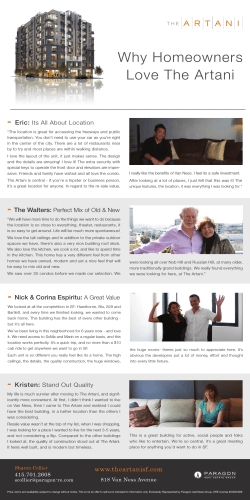
your ode to the electric motor - From the HeartHOMECollectie van
YOUR ODE TO THE ELECTRIC MOTOR From the heart: Your ode to the electric motor In an engine room deep in the hold, buried in a dark corner, hidden under layers of dust: 3000 rounds per minute, 500 kilowatts per hour and 680 horsepower of pure energy. Power embedded in one chunk of steel. It starts the diesel engines of the largest ships in the world, escorts groceries to the checkout and dries hair in front of the mirror. For three generations now, copper windings, magnetic fields and cooling ribs have ensured the happiness of the Van Bodegraven family. We wished to express this happiness, this proud love of the electric motor: and the idea of a collection was born. As an art lover with lack of creativity, I ask for the inspiration of like-minded artists. We invite you to develop a concept serving as an ode to the electric motor. The ten most appealing concepts will have an electric motor at their disposal in order to realise the idea. The work will be included in the Van Bodegraven Collection and will form part of a PR programme. For more information and preconditions www.collectievanbodegraven.com The occasion In 1937, Kees van Bodegraven started trading in all sorts of electrotechnical materials in Rotterdam. During the occupation, he was forced to hand everything over to the Germans. Yet he did not despair. On the contrary. The attic room on the Rotterdam Northern Island was refurbished, tables and chairs were bought and a training institute was born. Four evenings a week, Van Bodegraven Senior taught classes with a firm hand. His working method created a success rate of 100% in the national exams of the association for electrotechnical vocational education (Dutch name: VEV). Many leaders of today’s large companies such as GTI (now Cofely) and R&H – now known as Imtech Marine – gained their thorough knowledge here. His son, Ton van Bodegraven, was a businessman with a clear and modern vision and he dared to take risks. He knew exactly what he needed in order to grow. He summarised this in three words: money, time and space. From the moment he entered the company in 1962, it grew steadily. The company has now developed into a business with a large stock of rotary engines, DC motors and transformers. In an area of more than 7,500 m2 in Dordrecht, Frank van Bodegraven, representing the third generation, is now at the helm, in possession of thorough knowledge and a great deal of experience. Frank is a passionate man with a real love for the product he sells. He thinks in kilowatts, and at so many rounds per minute that you can barely keep up with him. He is also a very sociable person, always trying to convey his love for the electric motor to others. Most of all, he likes pointing them out in daily life. Yet they are always hidden in the steel housing of the conveyor belt at the supermarket, deep in the holds of ocean steamers, in the body of the latest Prius, or at the top of an elevator shaft in a block of flats. You can imagine the frustration. It was during a visit to the art hall where he visited a Caldic expo that the idea originated to give the electric motor the platform it deserves. De pitch. We ask you to create a work featuring the electric motor as ‘driving force’. Naturally, this may be interpreted both literally and figuratively. The appearance, the working, the strength, the agility, the indispensability or even the technique can be chosen as a theme. You must explain your concept on approximately 2 A4 sheets with text and, if necessary, supporting images/sketches. Then you upload this at www.collectievanbodegraven.com. You are free in terms of the techniques you use, just as you are in the choice of format and type of motor. We are curious about your creative, creating mind. Needless to say, entries featuring combinations of art disciplines are very welcome! What next? An assessment team consisting of various people from the world of art, technology and design will select ten winners from the entries, the first three of which will win a sum of money. Together with Frank, all winners will be able to choose an electric motor at the Van Bodegraven company to use for the project. From that moment on, they will be assisted as far as possible by the company in order to realise the work. This will include transport, workspace and/or test space with power current and technical advice. After the selection round, a deadline will of course be set. 1e prize: 2e prize: 3e prize: 3000,1500,500,- What will happen to my work afterwards? And what about rights and so on? EXPO BOOK PR PROPERTY After the completion of all ten works there will be an expo. Initially in an exhibition room at Van Bodegraven in Dordrecht, and subsequently, when there is enough interest, at as many other places as possible. An exhibition book will naturally be designed, featuring background information about the artist and their work. This book will be distributed on the corporate circuit as well as in the art world. The book will also serve as a press release for the art media, both in print and online. In addition, a free publicity campaign will be launched, focusing on the exhibition but also raising the profile of the individual artists. The work is and remains the property of both parties: Van Bodegraven as well as the artist. In the event the work is sold, Van Bodegraven will be compensated for the value of the motor used. The remaining funds will be for the benefit of the artist. Please note: Van Bodegraven assumes the role of curator of the collection. The sales value will be established in agreement with the artist. This is to guarantee the value and good name of the collection. Questions? Mail to [email protected] Good luck!
© Copyright 2025





















